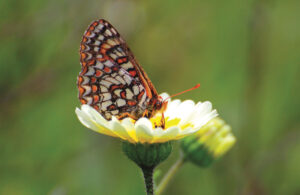Visitors to the San Francisco Bay in January 2019 were greeted with a sight not seen for decades: thousands of charismatic surf scoters bobbing merrily on the salty water. Male surf scoters are especially engrossing; their bright orange and white bills and white-ringed eyes stand in stark contrast with their sleek, mostly black, feathered bodies. Traditionally, as many as half of this diving sea duck’s Pacific Flyway population has overwintered in the Bay Area, scooping up clams and Pacific herring eggs in the waters of the region’s eelgrass beds. In the 1980s, up to 30,000 surf scoters were counted here.
But in the last three decades, researchers have observed a dramatic decline in the surf scoter numbers in the Bay Area, tied to a litany of challenges. Eelgrass beds, which support the herring roe scoters so enjoy, have declined. Climate warming has affected their tundra and boreal forest nesting grounds in Alaska. In 2007, the Cosco Busan oil spill killed more than 1,100 surf scoters, and the highly urbanized nature of the Bay places constant pressure on estuary ecosystems.
A joint U.S. Fish and Wildlife Service and U.S. Geological Survey of the Bay Area’s estuaries conducted midwinter each year reflects those challenges. From 2013 through 2017, researchers counted between 2,000 and just over 3,500 surf scoters each year.
Last year was different.
“The number of scoters was really high in 2018,” says Cheryl Strong, a wildlife biologist with the USFWS at the San Francisco Bay National Wildlife Refuge Complex, and author of the latest waterfowl survey. Strong says the survey, which has been around since the early 1980s, was originally contrived to ensure waterfowl hunting limits were set accurately. The agencies continue the survey once a year “because it’s our one good snapshot to look at duck distributions around the Bay and see what areas they’re using,” she says.
Birds, Strong adds, are some of nature’s best eco-indicators. From duck counts, scientists can get a much wider sense of how the Bay is doing.
“If you’ve got birds in a large area foraging, you can assume to some extent the invertebrate community is doing well, which says a lot about water quality and pollutants,” Strong says.

Surveyors split the San Francisco estuary into three regions that include the Outer Coast, San Francisco Bay and Suisun Bay. They conduct aerial surveys via helicopter, twin-engine plane or single-wing, single-engine Cessna, plus ground counts.
Near the end of 2018, researchers observed 14,562 surf scoters. Nearly 9,000 were counted in the Central Bay, more than the total number of surf scoters counted during the previous five surveys combined. But scientists aren’t quite ready to call it a comeback. John Takekawa, operations manager for the Suisun Resource Conservation District, and longtime waterfowl research biologist with the USGS and Audubon, says piecing together what may be behind 2018’s strong surf scoter numbers is like trying to do a puzzle without all of the pieces.
“I’d call it hopeful,” he says of the results. “The real truth is you need to two to three years of numbers before you believe it. One year, it’s hard to know if it’s a trend.”
One reason is linked to the source of the information itself: the San Francisco Estuary Midwinter Waterfowl Survey. Survey Coordinator Strong says the quality of the data is largely dependent on mother nature herself. Fog, a staple in the Bay, makes for bad bird counting conditions. Similarly, in some years, areas are not surveyed due to funding limitations or other challenges.
“This is a one day a year survey and it has so many limitations,” she says. But, she adds, its importance as indicator of waterfowl health in the region is hard to overstate: “It is the only game in town.”
Both Takekawa and Strong caution the high numbers in 2018 could be a blip. They note it could be that the number of wintering surf scoter in other places, like Southern California, were low this year. More may have simply chosen to spend time in the Bay. Still, these sea ducks are sensitive species; they respond to the presence, or lack thereof, of food resources. In 2018, researchers observed a similar population bump for the scaup, a mid-sized diving duck similar to the surf scoter. Takekawa says that’s a positive sign it’s not a blip — that the health of the Bay is probably doing well.
“To me this indicates the Bay is healthy and contribution to the flyway is strong, and we hope it stays that way,” he says.





